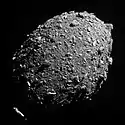2015 DR215
2015 DR215 is a stony near-Earth asteroid of the Atira class residing within Earth's orbit. It was discovered on 18 February 2015 by the Pan-STARRS 1 survey at Haleakalā Observatory at Maui, Hawaiʻi.[1][2] The asteroid has a diameter of about 200 m (660 ft)[4] and makes close approaches within 0.05 AU (7.5 million km; 4.6 million mi) of Earth, making it a potentially hazardous object.[3] On 11 March 2022, it made a close approach 0.045 AU (6.7 million km; 4.2 million mi) from Earth,[3] reaching a peak apparent magnitude of 17 as it streaked across the southern sky.[1]
| Discovery[1][2] | |
|---|---|
| Discovered by | Pan-STARRS 1 |
| Discovery site | Haleakalā Obs. |
| Discovery date | 18 February 2015 |
| Designations | |
| 2015 DR215 | |
| NEO · Atira · PHA[3][1] | |
| Orbital characteristics[3] | |
| Epoch 21 January 2022 (JD 2459600.5) | |
| Uncertainty parameter 0 | |
| Observation arc | 7.12 yr (2,602 days) |
| Aphelion | 0.9809 AU |
| Perihelion | 0.3522 AU |
| 0.6665 AU | |
| Eccentricity | 0.4716 |
| 0.54 yr (199 days) | |
| 74.459° | |
| 1° 48m 40.325s / day | |
| Inclination | 4.085° |
| 314.961° | |
| 42.298° | |
| Earth MOID | 0.044412 AU (6,643,900 km) |
| Physical characteristics | |
Mean diameter | 205 m[4] |
| 0.266[4] | |
| Sr[4] | |
| 20.51[3] | |
Discovery
2015 DR215 was discovered on 18 February 2015 by the Pan-STARRS 1 survey at Haleakalā Observatory at Maui, Hawaiʻi.[2] It was first observed at apparent magnitude 20.7, located in the southern sky 28 degrees below the ecliptic with an angular separation (solar elongation) of 76 degrees from the Sun.[2] Follow-up observations from the Mauna Kea Observatory and Cerro Tololo Inter-American Observatory commenced, establishing an observation arc of 12 days until its discovery announcement by the Minor Planet Center on 2 March 2015.[2]
On 5 March 2016, 2015 DR215 was recovered by the ESA Optical Ground Station at apparent magnitude 19, at solar elongations below 56 degrees.[5] It was observed to be about 0.5 degrees away from its predicted positions in March 2016.[5] The recovery observations significantly reduced the asteroid's orbital uncertainty, bringing its uncertainty parameter down from 9 to 3.[2][5]
As of 2022, 2015 DR215 has been observed for over 7 years, with a well-determined orbit at an uncertainty parameter of 0.[3]
Classification
2015 DR215 is one of a small number of Atira class asteroids that are orbiting entirely within the Earth's orbit.[6] The taxonomic class of 2015 DR215 in the Bus–DeMeo scheme is Sr, indicating a stony composition.[4]
Numbering and naming
As of 2023, this minor planet has neither been numbered nor named by the Minor Planet Center.
References
- "2015 DR215". Minor Planet Center. Retrieved 17 April 2021.
- "MPEC 2015-E12 : 2015 DR215". Minor Planet Electronic Circulars. Minor Planet Center. 2 March 2015. Retrieved 17 April 2021.
- "JPL Small-Body Database Browser: (2015 DR215)" (2022-04-04 last obs.). Jet Propulsion Laboratory. Retrieved 17 April 2021.
- Perna, D.; Barucci, M. A.; Fulchignoni, M.; Popescu, M.; Belskaya, I.; Fornasier, S.; et al. (August 2018). "A spectroscopic survey of the small near-Earth asteroid population: Peculiar taxonomic distribution and phase reddening". Planetary and Space Science. 157: 82–95. arXiv:1803.08953. Bibcode:2018P&SS..157...82P. doi:10.1016/j.pss.2018.03.008.
- "MPEC 2016-E72 : 2015 DR215". Minor Planet Electronic Circulars. Minor Planet Center. 7 March 2016. Retrieved 17 April 2021.
- de la Fuente Marcos, C.; de la Fuente Marcos, R. (August 2019). "Understanding the evolution of Atira-class asteroid 2019 AQ3, a major step towards the future discovery of the Vatira population". Monthly Notices of the Royal Astronomical Society. 487 (2): 2742–2752. arXiv:1905.08695. Bibcode:2019MNRAS.487.2742D. doi:10.1093/mnras/stz1437.
External links
- 2015 DR215 at NeoDyS-2, Near Earth Objects—Dynamic Site
- 2015 DR215 at ESA–space situational awareness
- 2015 DR215 at the JPL Small-Body Database

